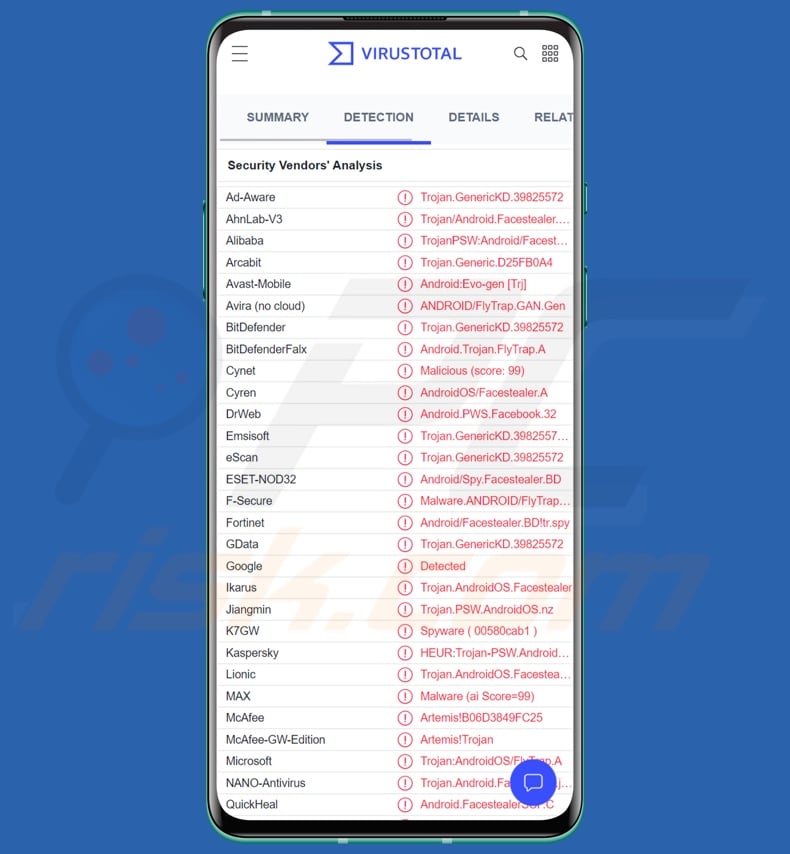Get free scan and check if your device is infected.
Remove it nowTo use full-featured product, you have to purchase a license for Combo Cleaner. Seven days free trial available. Combo Cleaner is owned and operated by RCS LT, the parent company of PCRisk.com.
What is FlyTrap?
FlyTrap is a piece of malicious software classified as a trojan. This malware targets Android Operating Systems (OSes). The primary goal of FlyTrap is to steal and abuse Facebook accounts and related data.
According to the research done by Zimperium, this malware has been active in over one hundred countries and has successfully compromised the accounts of at least ten thousand users. Additionally, Zimperium's findings reveal evidence linking FlyTrap to Vietnamese cyber criminals.

FlyTrap malware overview
As mentioned in the introduction, the FlyTrap trojan targets Facebook accounts. The observed infection chain begins with a malicious application relating to coupons, discounts, or popularity polls. The victim interacts with these apps (e.g., receives instructions on how to apply the fake discount codes, votes on polls, etc.) until they are presented with a verification process that requires logging into their Facebook account.
Following a successful log-in, FlyTrap initiates its operations. This trojan employs JavaScript injection techniques through which it can access legitimate websites in order to extract information and inject malicious JavaScript code. FlyTrap targets the following data: IP address (geolocation), email address, Facebook ID, as well as associated Internet cookies and tokens.
Hijacked social networking/media accounts can have varied uses. By stealing the victim's identity, the cyber criminals automatically acquire the account owner's credibility - hence, they can ask the contacts/friends for loans or proliferate malware by sharing malicious links or files. There are even instances where the criminals further their own agenda and use stolen accounts to spread misinformation or propaganda.
To summarize, FlyTrap infections can result in severe privacy issues, identity theft, and significant financial losses.
If you suspect that your device is infected with this or other malware, we strongly recommend using an anti-virus to remove it without delay.
| Name | FlyTrap malware |
| Threat Type | Android Trojan, Trojan, Android malware, malicious application. |
| Detection Names | Avast-Mobile (Android:Evo-gen [Trj]), DrWeb (Android.PWS.Facebook.32), ESET-NOD32 (Android/Spy.Facestealer.BD), Kaspersky (HEUR:Trojan-PSW.AndroidOS.Facestea), Full List (VirusTotal) |
| Symptoms | The device is running slow, system settings are modified without user's permission, questionable applications appear, data and battery usage is increased significantly, browsers redirect to questionable websites, intrusive advertisements are delivered. |
| Distribution methods | Infected email attachments, malicious online advertisements, social engineering, deceptive applications, scam websites. |
| Damage | Stolen personal information (private messages, logins/passwords, etc.), decreased device performance, battery is drained quickly, decreased Internet speed, huge data losses, monetary losses, stolen identity (malicious apps might abuse communication apps). |
| Malware Removal (Windows) |
To eliminate possible malware infections, scan your computer with legitimate antivirus software. Our security researchers recommend using Combo Cleaner. Download Combo CleanerTo use full-featured product, you have to purchase a license for Combo Cleaner. 7 days free trial available. Combo Cleaner is owned and operated by RCS LT, the parent company of PCRisk.com. |
Android-targeting malware examples
There is a wide variety of malware, which can have a broad range of functionalities and uses. These programs can range from information stealers to data-encrypting or screen-locking ransomware. RatMilad, CapraRAT, Triada, and S.O.V.A. are just a few examples of Android-specific malware that we have researched recently.
It must be emphasized that regardless of how malicious software operates - its presence on a system endangers device integrity and user safety. Therefore, it is essential to eliminate threats immediately upon detection.
How did FlyTrap infiltrate my device?
FlyTrap has been distributed in the form of variously disguised malicious apps. The researched applications were presented as coupon and discount code generators for services like Netflix, Google AdWords, and others. Football (soccer) related apps have been in use as well; these centered various polls and voting for the best football leagues, teams, and players.
The malicious applications were spread through the Google Play Store and questionable third-party download sources. While FlyTrap-related content has already been removed from the Play Store - that is not the case with untrustworthy third-party platforms.
It is pertinent to mention that cyber criminals often attempt to abuse legitimate download channels, despite the potentially swift removal by the review teams of such platforms.
It is possible that the FlyTrap trojan is distributed using other methods as well. Generally, malware is most widely proliferated via drive-by (stealthy/deceptive) downloads, freeware and free file-hosting websites, P2P sharing networks (e.g., Torrent clients, eMule, Gnutella, etc.), online scams, spam mail (e.g., emails, SMSes, PMs/DMs, etc.), illegal software activation ("cracking") tools and pirated content, fake updates, and malvertising.
How to avoid installation of malware?
We highly recommend researching software before download/installation and/or purchase, e.g., by reading terms and user/expert reviews, checking out the necessary permissions, verifying developer legitimacy, etc. All downloads must be performed from official and verified sources.
It is essential to activate and update software using genuine functions/tools, as illegal activation tools ("cracks") and third-party updaters may contain malware.
Another recommendation is to be vigilant when browsing since fraudulent and malicious material typically appears legitimate and innocuous. We advise against opening the attachments and links found in suspicious/irrelevant emails, text messages, PMs/DMs, etc. - as they can be malicious and cause system infections.
We must emphasize the importance of having a dependable anti-virus installed and updated. Security programs must be used to run regular system scans and to remove threats and issues.
Examples of FlyTrap's malicious applications (image source - Zimperium):
Examples of the verification processes displayed by these apps (image source - Zimperium):
Quick menu:
- Introduction
- How to delete browsing history from the Chrome web browser?
- How to disable browser notifications in the Chrome web browser?
- How to reset the Chrome web browser?
- How to delete browsing history from the Firefox web browser?
- How to disable browser notifications in the Firefox web browser?
- How to reset the Firefox web browser?
- How to uninstall potentially unwanted and/or malicious applications?
- How to boot the Android device in "Safe Mode"?
- How to check the battery usage of various applications?
- How to check the data usage of various applications?
- How to install the latest software updates?
- How to reset the system to its default state?
- How to disable applications that have administrator privileges?
Delete browsing history from the Chrome web browser:

Tap the "Menu" button (three dots on the right-upper corner of the screen) and select "History" in the opened dropdown menu.

Tap "Clear browsing data", select "ADVANCED" tab, choose the time range and data types you want to delete and tap "Clear data".
Disable browser notifications in the Chrome web browser:

Tap the "Menu" button (three dots on the right-upper corner of the screen) and select "Settings" in the opened dropdown menu.

Scroll down until you see "Site settings" option and tap it. Scroll down until you see "Notifications" option and tap it.

Find the websites that deliver browser notifications, tap on them and click "Clear & reset". This will remove permissions granted for these websites to deliver notifications. However, once you visit the same site again, it may ask for a permission again. You can choose whether to give these permissions or not (if you choose to decline the website will go to "Blocked" section and will no longer ask you for the permission).
Reset the Chrome web browser:

Go to "Settings", scroll down until you see "Apps" and tap it.

Scroll down until you find "Chrome" application, select it and tap "Storage" option.

Tap "MANAGE STORAGE", then "CLEAR ALL DATA" and confirm the action by taping "OK". Note that resetting the browser will eliminate all data stored within. This means that all saved logins/passwords, browsing history, non-default settings and other data will be deleted. You will also have to re-login into all websites as well.
Delete browsing history from the Firefox web browser:

Tap the "Menu" button (three dots on the right-upper corner of the screen) and select "History" in the opened dropdown menu.

Scroll down until you see "Clear private data" and tap it. Select data types you want to remove and tap "CLEAR DATA".
Disable browser notifications in the Firefox web browser:

Visit the website that is delivering browser notifications, tap the icon displayed on the left of URL bar (the icon will not necessarily be a "Lock") and select "Edit Site Settings".

In the opened pop-up opt-in the "Notifications" option and tap "CLEAR".
Reset the Firefox web browser:

Go to "Settings", scroll down until you see "Apps" and tap it.

Scroll down until you find "Firefox" application, select it and tap "Storage" option.

Tap "CLEAR DATA" and confirm the action by taping "DELETE". Note that resetting the browser will eliminate all data stored within. This means that all saved logins/passwords, browsing history, non-default settings and other data will be deleted. You will also have to re-login into all websites as well.
Uninstall potentially unwanted and/or malicious applications:

Go to "Settings", scroll down until you see "Apps" and tap it.

Scroll down until you see a potentially unwanted and/or malicious application, select it and tap "Uninstall". If, for some reason, you are unable to remove the selected app (e.g., you are prompted with an error message), you should try using the "Safe Mode".
Boot the Android device in "Safe Mode":
The "Safe Mode" in Android operating system temporarily disables all third-party applications from running. Using this mode is a good way to diagnose and solve various issues (e.g., remove malicious applications that prevent users you from doing so when the device is running "normally").

Push the "Power" button and hold it until you see the "Power off" screen. Tap the "Power off" icon and hold it. After a few seconds the "Safe Mode" option will appear and you'll be able run it by restarting the device.
Check the battery usage of various applications:

Go to "Settings", scroll down until you see "Device maintenance" and tap it.

Tap "Battery" and check the usage of each application. Legitimate/genuine applications are designed to use as low energy as possible in order to provide the best user experience and to save power. Therefore, high battery usage may indicate that the application is malicious.
Check the data usage of various applications:

Go to "Settings", scroll down until you see "Connections" and tap it.

Scroll down until you see "Data usage" and select this option. As with battery, legitimate/genuine applications are designed to minimize data usage as much as possible. This means that huge data usage may indicate presence of malicious application. Note that some malicious applications might be designed to operate when the device is connected to wireless network only. For this reason, you should check both Mobile and Wi-Fi data usage.

If you find an application that uses a lot of data even though you never use it, then we strongly advise you to uninstall it as soon as possible.
Install the latest software updates:
Keeping the software up-to-date is a good practice when it comes to device safety. The device manufacturers are continually releasing various security patches and Android updates in order to fix errors and bugs that can be abused by cyber criminals. An outdated system is way more vulnerable, which is why you should always be sure that your device's software is up-to-date.

Go to "Settings", scroll down until you see "Software update" and tap it.

Tap "Download updates manually" and check if there are any updates available. If so, install them immediately. We also recommend to enable the "Download updates automatically" option - it will enable the system to notify you once an update is released and/or install it automatically.
Reset the system to its default state:
Performing a "Factory Reset" is a good way to remove all unwanted applications, restore system's settings to default and clean the device in general. However, you must keep in mind that all data within the device will be deleted, including photos, video/audio files, phone numbers (stored within the device, not the SIM card), SMS messages, and so forth. In other words, the device will be restored to its primal state.
You can also restore the basic system settings and/or simply network settings as well.

Go to "Settings", scroll down until you see "About phone" and tap it.

Scroll down until you see "Reset" and tap it. Now choose the action you want to perform:
"Reset settings" - restore all system settings to default;
"Reset network settings" - restore all network-related settings to default;
"Factory data reset" - reset the entire system and completely delete all stored data;
Disable applications that have administrator privileges:
If a malicious application gets administrator-level privileges it can seriously damage the system. To keep the device as safe as possible you should always check what apps have such privileges and disable the ones that shouldn't.

Go to "Settings", scroll down until you see "Lock screen and security" and tap it.

Scroll down until you see "Other security settings", tap it and then tap "Device admin apps".

Identify applications that should not have administrator privileges, tap them and then tap "DEACTIVATE".
Frequently Asked Questions (FAQ)
My Android device is infected with FlyTrap malware, should I format my storage device to get rid of it?
No, most malicious programs can be removed without such drastic measures.
What are the biggest issues that FlyTrap malware can cause?
FlyTrap targets Facebook accounts, which could then be used to send monetary loan/donation requests to the victim's friends, proliferate malware, promote scams, push disinformation, etc. Therefore, FlyTrap infections can result in severe privacy issues, identity theft, and significant financial losses.
What is the purpose of FlyTrap malware?
Typically, malware is employed to generate revenue. However, cyber criminals can also use malicious software to amuse themselves, carry out personal vendettas, disrupt processes (e.g., websites, services, etc.), and even launch politically/geopolitically motivated attacks.
How did FlyTrap malware infiltrate my Android device?
FlyTrap has been observed being proliferated under the guise of discount-generating and popularity poll applications. These apps were available on the Google Play Store and, at the time of research, are still promoted on various questionable download sources.
In general, malware is primarily spread via drive-by downloads, untrustworthy download channels (e.g., freeware and free file-hosting sites, P2P sharing networks, etc.), online scams, spam emails and messages, illegal software activation ("cracking") tools, fake updates, and malvertising.
Share:

Tomas Meskauskas
Expert security researcher, professional malware analyst
I am passionate about computer security and technology. I have an experience of over 10 years working in various companies related to computer technical issue solving and Internet security. I have been working as an author and editor for pcrisk.com since 2010. Follow me on Twitter and LinkedIn to stay informed about the latest online security threats.
PCrisk security portal is brought by a company RCS LT.
Joined forces of security researchers help educate computer users about the latest online security threats. More information about the company RCS LT.
Our malware removal guides are free. However, if you want to support us you can send us a donation.
DonatePCrisk security portal is brought by a company RCS LT.
Joined forces of security researchers help educate computer users about the latest online security threats. More information about the company RCS LT.
Our malware removal guides are free. However, if you want to support us you can send us a donation.
Donate




▼ Show Discussion